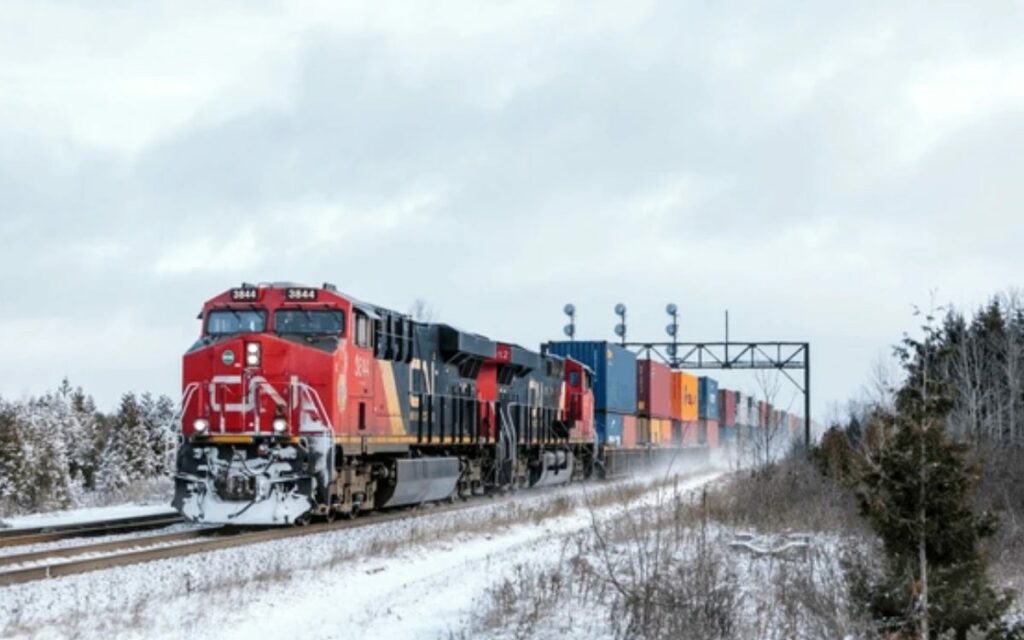
Canadian policymakers seem only interested in railroads reactively and not proactively. Unless there’s a crisis, they are ignored. Photo Credit: Shutterstock.
The labour dispute that threatens Canada’s rail service will come and go, but the lack of a national transportation policy is a deeper, more systemic, and long-lasting problem that needs to be addressed.
Every major Canadian business has had headaches and concern at the impasse between Canadian National Railway and Canadian Pacific Kansas City Railway and the Teamsters Canada Rail Conference. Railways carry upwards of $380 billion of goods annually, including more than $200 billion destined for export.
Canada was built on railways and they remain the nation’s vital arteries for the resource-based economy and the transportation of goods. The companies have offered binding arbitration to unions, but they have refused, and the federal government is unwilling to impose it.
The Liberal government, upheld by an agreement with the New Democrats, are loathe to interfere with collective bargaining. Even when confronted with the necessity of chlorine shipments for water treatment plants, the Canadian Industrial Relations Board refused to call rail service essential for the safety and security of Canadians.
The U.S. has a domestic transportation policy that pays better attention to bottlenecks, not to mention 12 railway companies. And this is a country with good roads and consumers all over, making rail travel somewhat less vital than in Canada. Regardless, when a national labour impasse threatened rail service in 2022, the government made a tentative deal. When the unions rejected the deal, the government legislated it, feeling it had no other alternative.
Unfortunately, Canadian policymakers seem only interested in railroads reactively and not proactively. Unless there’s a crisis, they are ignored. The problem is that this approach can lend itself to systemic problems that make crises more frequent.
Ottawa should not have stopped paying attention to rail after CN was privatized in 1995. Free market competition is helpful in many respects, but when the competitors number only two, some typical advantages diminish. Because CN and CPKC are publicly traded, the concerns of shareholders wanting big returns can easily overshadow attention to infrastructure.
Left to themselves, Canada’s two rail companies run at full capacity on minimal assets. This leaves a rail system unable to respond well when disaster strikes, whether due to labour disputes, mother nature, or mechanical failure.
Consider the railway bridge that collapsed near Fort Frances, Ontario, severing a vital CN line between Winnipeg and Thunder Bay. The timing for Manitoba farmers and elevators eager to ship out the harvest could not be worse.
CN used to have a second line from Sioux lookout to Thunder Bay, but that was removed several years ago. CP used to have a double-track line from Winnipeg to Thunder Bay, but they reduced that to a single line in the 1990s.
The commercial interest and the national interest are two different things. A system with no resiliency or redundancy is unable to respond to crisis.
Uncertainties in Canada’s supply chains have damaged the country’s reputation to foreign importers. Canadian companies face international doubts when trying to secure contracts at good prices. The nation underachieves, despite an abundance of resources.
A recent study by the C.D. Howe Institute said Canada needs a strategy not only for transportation, but also communication, the electrical grid, and pipelines. The institute found a lack of pipeline capacity for gas and diesel cost B.C. $1.5 billion annually, as excess demand had to be met through rail–a more expensive option. This dollar figure had only the cost to B.C. motorists in view. It was almost certainly dwarfed by the economic impact of missed opportunities for Canada’s energy sector and exports.
In 2021, the European Court of Auditors benchmarked its transportation strategy against those in Australia, Switzerland, the U.S., France, and Canada. Its conclusion was Canada was alone in effectively having no strategy at all.
Part of the problem is due to Canada’s constitutional approach. Pipelines and railways fall to national attention, while highways get to provincial attention. As a result, provinces usually sink money into highways, not railways, despite the potential to offset demand on roads and lower maintenance costs.
Split jurisdiction between provincial and federal governments also inhibits Canada from providing the same kinds of investment opportunities into infrastructure as other nations have done. That’s why many investment and pension funds are putting their money on foreign projects instead of ones at home.
The transmountain pipeline project, initially expected to finish in 2019 for just over $5 billion, finished in May at a cost of just over $30 billion. Canada’s onerous and slow-moving regulatory scheme make foreign investors shy too. When will this country finally reach its full potential?






